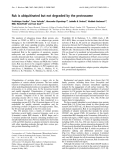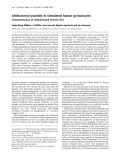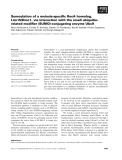
Ubiquitinated
-
Bài giảng Sinh học phân tử: Chương 5 Quá trình sinh tổng hợp Protein, cung cấp cho người học những kiến thức như: RNA thông tin (mRNA); Cấu trúc RNA vận chuyển; Đột biến làm thay đổi khung đọc; Quá trình dịch mã (Translation); Sự phân tách của Ribosome;...Mời các bạn cùng tham khảo!
 35p
35p  caphesuadathemmatong
caphesuadathemmatong
 25-11-2021
25-11-2021
 39
39
 3
3
 Download
Download
-
BTG/Tob family proteins, which are characterized by similarities in their N-terminal BTG/Tob homology domains, control cell growth negatively. Among the BTG/ Tob family members, BTG2/TIS21/PC3 proteins have been reported to have short lives and to be degraded by the proteasome. However, the mechanisms regulating the stabilities of other BTG/Tob family proteins have not yet been clarified.
 9p
9p  research12
research12
 01-06-2013
01-06-2013
 31
31
 4
4
 Download
Download
-
The regulator of ubiquitous kinase (Ruk) protein, also known as CIN85 or SETA, is an adaptor-type protein belonging to the CD2AP/CMS family. It was found in complexes with many signaling proteins, including phos1 phoinositol (PtdIns) 3-kinase (EC 2.7.1.137), Cbl, GRB2, p130Cas and Crk. Functional analysis of these interactions, implicated Ruk in the regulation of apoptosis, receptor endocytosis and cytoskeletal rearrangements.
 7p
7p  research12
research12
 01-06-2013
01-06-2013
 29
29
 4
4
 Download
Download
-
Antizyme is a polyamine-induced cellular protein that binds to ornithine decarboxylase (ODC), and targets it to rapid ubiquitin-independent degradation by the 26S proteasome. However, the metabolic fate of antizyme is not clear. We have tested the stability of antizyme in mammalian cells. In contrast with previous studies demonstrating stability in vitro in a reticulocyte lysate-based degradation system, in cells antizyme is rapidly degraded and this degradation is inhibited by specific proteasome inhibitors. ...
 7p
7p  research12
research12
 01-06-2013
01-06-2013
 43
43
 3
3
 Download
Download
-
Murine double minute 2 (MDM2) protein exhibits many diverse biochemi-cal functions on the tumour suppressor protein p53, including transcrip-tional suppression and E3 ubiquitin ligase activity. However, more recent data have shown that MDM2 can exhibit ATP-dependent molecular chap-erone activity and directly mediate folding of the p53 tetramer. Analysing the ATP-dependent function of MDM2 will provide novel insights into the evolution and function of the protein.
 12p
12p  research12
research12
 29-04-2013
29-04-2013
 62
62
 4
4
 Download
Download
-
Tyrosine hydroxylase (TH) demonstrates by two-dimen-sional electrophoresis amicroheterogeneitybothas a soluble recombinant humanTH(hTH1) andas amembrane-bound bovine TH (bTHmem). Part of the heterogeneity is likely due to deamidation of labile asparagine residues. Wild-type (wt)-hTH1was foundtobeasubstrate for theubiquitin(Ub) conjugating enzyme systemina reconstitutedin vitrosystem.
 9p
9p  research12
research12
 29-04-2013
29-04-2013
 63
63
 4
4
 Download
Download
-
Antibacterial peptides were isolated fromhuman peripheral granulocytes of a healthy donor who had been treated with granulocyte-colony stimulating factor (G-CSF) and cortisol. Peptides were solubilized in acidi®ed chloroform/methanol, and partitioned in chloroform/methanol/water. Water-soluble polypeptides were separated by cation-exchange and reversed-phase chromatography. Several previously char-acterized antibacterial polypeptides were identi®ed; defen-sins 1±3, defensin 4, lysozyme, eosinophil cationic protein, and calgranulin A. ...
 7p
7p  research12
research12
 23-04-2013
23-04-2013
 26
26
 3
3
 Download
Download
-
Monoclonal nonspecific suppressor factor (MNSF) is a cytokine with antigen nonspecific suppressive activity. MNSFb(a subunit of MNSF) is a 14.5kDa fusion protein consisting of a proteinwith 36%identitywith ubiquitin and ribosomal protein S30. The ubiquitin-like segment (Ubi-L) may be cleaved from MNSFbin the cytosol. Recently, we have observed that Ubi-L covalently binds to intracellular proteins in mitogen-activated murine T-helper type 2 clone, D.10 cells.
 7p
7p  tumor12
tumor12
 20-04-2013
20-04-2013
 35
35
 3
3
 Download
Download
-
The COP9 signalosome (CSN) occurs in all eukaryotic cells. It is a regula-tory particle of the ubiquitin (Ub)⁄26S proteasome system. The eight sub-units of the CSN possess sequence homologies with the polypeptides of the 26S proteasome lid complex and just like the lid, the CSN consists of six subunits with PCI (proteasome, COP9 signalosome, initiation factor 3) domains and two components with MPN (Mpr-Pad1-N-terminal) domains.
 9p
9p  fptmusic
fptmusic
 11-04-2013
11-04-2013
 23
23
 1
1
 Download
Download
-
Substitution oftrans-proline at three positions in ubiquitin (residues 19, 37 and 38) produces significant context-dependent effects on protein stability (both stabilizing and destabilizing) that reflect changes to a combination of parameters including backbone flexibility, hydrophobic interactions, solvent accessibility to polar groups and intrinsic backbone conformational preferences. Kinetic analysis of thewild-type yeast protein reveals a predominant fast-folding phase which conforms to an apparent two-state folding model. ...
 11p
11p  awards
awards
 05-04-2013
05-04-2013
 49
49
 4
4
 Download
Download
-
The SUMO proteins are a class of small ubiquitin-like modifiers. SUMO is attached to a specific lysine side chain on the target protein via an isopeptide bond with its C-terminal glycine.Thereareat least fourSUMOproteins in humans, which are involved in protein trafficking and tar- geting. A truncated human SUMO-2 protein that contains residues 9–93 was expressed inEscherichia coliand crystal- lized in two different unit cells, with dimensions of a ¼b¼ 75.25 A ˚ ,c¼29.17 A ˚ and a¼b¼74.96 A ˚ ,c¼33.23 A ˚ , both belonging to the rhombohedral space groupR3. They diffractedX-rays to1.
 9p
9p  awards
awards
 05-04-2013
05-04-2013
 43
43
 4
4
 Download
Download
-
NEDD8 is a ubiquitin-like protein that controls vital bio-logical events through its conjugation to target proteins. Previously, we identifieda negative regulator oftheNEDD8 conjugation system, NEDD8 ultimate buster-1 (NUB1), that recruits NEDD8 and its conjugates to the proteasome for degradation. Recently, we performed yeast two-hybrid screening with NUB1 as bait and isolated a ubiquitin pre-cursor UbC1 that is composed ofnine tandem repeats of a ubiquitin unit through a-peptide bonds.
 11p
11p  dell39
dell39
 03-04-2013
03-04-2013
 34
34
 5
5
 Download
Download
-
The Rpn10 subunit of the 26S proteasome can bind to polyubiqui-tinoylated and⁄or ubiquitin-like proteins via ubiquitin-interacting motifs (UIMs). Vertebrate Rpn10 consists of five distinct spliced isoforms, but the specific functions of these variants remain largely unknown.
 14p
14p  dell39
dell39
 27-03-2013
27-03-2013
 47
47
 4
4
 Download
Download
-
The suppressors of cytokine signalling (SOCS) proteins inhibit cytokine signalling by direct interaction with Janus kinases (JAKs) or activated cytokine receptors. In addition to the N-ter-minal and SH2 domains that mediate these interactions, SOCS proteins contain a C-terminal SOCS box. Evidence suggests SOCS box-containing proteins act as part of an elongin-cullin-SOCS (ECS) E3 ubiquitin ligase complex, marking target pro-teins for degradation.
 35p
35p  inspiron33
inspiron33
 26-03-2013
26-03-2013
 58
58
 6
6
 Download
Download
-
The protein ataxin-3 is responsible for spinocerebellar ataxia type 3, a neu-rodegenerative disease triggered when the length of a stretch of consecutive glutamines exceeds a critical threshold. Different physiologic roles have been suggested for this protein. More specifically, recent papers have shown that the highly conserved N-terminal Josephin domain of ataxin-3 binds ubiquitin and has ubiquitin hydrolase activity, thanks to a catalytic device specific to cysteine proteases.
 10p
10p  inspiron33
inspiron33
 25-03-2013
25-03-2013
 37
37
 5
5
 Download
Download
-
Sumoylation is a post-translational modification system that covalently attaches the small ubiquitin-related modifier (SUMO) to target proteins. Ubc9 is required as the E2-type enzyme for SUMO-1 conjugation to tar-gets. Here, we show that Ubc9 interacts with the meiosis-specific RecA homolog, Lim15⁄Dmc1 in the basidiomyceteCoprinus cinereus(CcLim15), and mediates sumoylation of CcLim15 during meiosis.
 10p
10p  inspiron33
inspiron33
 25-03-2013
25-03-2013
 39
39
 5
5
 Download
Download
-
Serum- and glucocorticoid-induced protein kinase-1 (SGK-1) plays a crit-ical role in regulation of the epithelial sodium channel, ENaC. SGK-1 also shares significant catalytic domain homology with protein kinase B (PKB⁄AKT-1) and is a downstream effector of antiapoptotic phosphoinos-itide 3-kinase signaling.
 16p
16p  inspiron33
inspiron33
 25-03-2013
25-03-2013
 34
34
 3
3
 Download
Download
-
Cbl is an adaptor protein and ubiquitin ligase that binds and is phosphory-lated by the nonreceptor tyrosine kinase Src. We previously showed that the primary interaction between Src and Cbl is mediated by the Src homology domain 3 (SH3) of Src binding to proline-rich sequences of Cbl.
 15p
15p  inspiron33
inspiron33
 23-03-2013
23-03-2013
 38
38
 4
4
 Download
Download
-
In this review, we describe the role of a small ubiquitin-like protein modi-fier (SUMO)-conjugating protein, Ubc9, in synaptonemal complex forma-tion during meiosis in a basidiomycete, Coprinus cinereus. Because its meiotic cell cycle is long and naturally synchronous, it is suitable for molecular biological, biochemical and genetic studies of meiotic prophase events.
 13p
13p  galaxyss3
galaxyss3
 19-03-2013
19-03-2013
 27
27
 2
2
 Download
Download
-
Potassium channel tetramerization domain (KCTD) proteins contain a bric-a-brac, tramtrak and broad complex (BTB) domain that is most simi-lar to the tetramerization domain (T1) of voltage-gated potassium chan-nels.
 11p
11p  galaxyss3
galaxyss3
 07-03-2013
07-03-2013
 40
40
 3
3
 Download
Download
CHỦ ĐỀ BẠN MUỐN TÌM

































